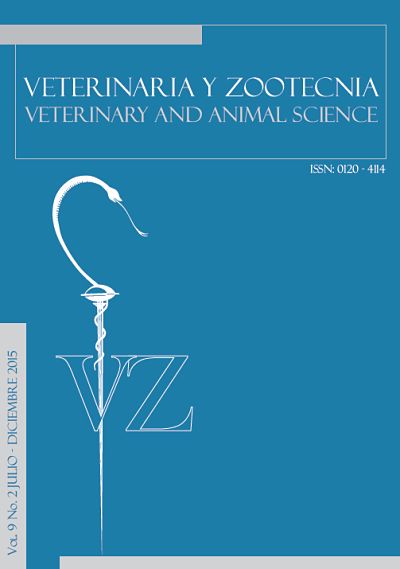Authors
Abstract
This study evaluated the ability of juvenile white Pirapitinga to select food with different tryptophan content in order to self-balance the amino acid intake using information originated from the food source. Therefore, how Tryptophan (Trp) intake affected self-balance of food and productive performance is assessed. The experiment consisted in providing diets supplemented with Trp and a control diet to juveniles with initial weight from 46.99 to 47.59 g as follows: Rc (0.32% Trp - control ration), R2 - 0.64% Trp, R4 - 1.28% Trp and R6 - 1.92% Trp. The number of the diet corresponds to the number Trp was multiplied by in the control diet . Two hand-made feeders were used at the bottom of the aquarium in which 2% of the fish live weight was placed in each diet per day for 14 days. The results showed that the white Pirapitinga was able to self-balance the daily consumption of Trp, benefiting food consumption, weight gain and standard length, as well as food conversion. In conclusion, juvenile Pirapitinga can regulate the tryptophan consumption at a 0.80% level in the diet, equivalent to 20.69 mg/day.
Keywords
References
Botero M. Comportamiento de los peces en la búsqueda y la captura del alimento.Revista Colombiana de Ciencia y Pecuaria, v.17, p.63-75, 2004.
Bordinhon, A.M., Pezzato, L.E., Ducatti, C., Denadai, J.C., Barros, M.M. The Ability of Nile Tilapia to Regulate Protein and Energy Intake Evaluated by Carbon Relative Enrichment (δ13c). Journal of Agricultural Science and Technology B3, p. 45-55, 2013.
Coldevella, I.J., Besold, C., Fiori, L.N. Reprodução e criação da Tilápia-do-Nilo. In: Barcellos, L.J.G.; Fagundes, M. Policultivo de jundiás, tilápias e carpas: uma alternativa de produção para piscicultura rio-grandense. 2012. p.180-196. Passo Fundo: Associação Brasileira das Editoras Universitárias. Segunda edição.
Dapoza, C. Porcicultura.com pecuarios. Online, México. El Triptofano en la nutrición porcina. 2011. Disponible en: http://www.ganaderia.com.mx/porcicultura/home/articulos_int.asp?cve_art=680Access in: 09/08/2014.
Feijo, F.M., Bertoluci, M.C., Reis, C. Serotonina e controle hipotalâmico da fome: uma revisão. Revista da Associação Médica Brasileira, São Paulo, v.57, 1, p. 74-77, 2011.
Fortes-Silva, R., Martínez, F.J., Villarroel, M., Sánchez-Vázquez, F.J. Daily feeding patterns and self-selection of dietary oil in Nile tilapia. Aquaculture Research, v.42, p.157-160, 2010.
Freitas-Pinheiro, S.R, De Toledo S.L.B, Teixeira L.F.A, Rostagno H.S, TieUmigi R, Oliveira C.B. Efeito dos níveis de triptofano digestível em dietas para codornas japonesas em postura. Revista Brasileira de Zootecnia, v.37, 6, p. 1012-1016, 2008.
Kaiser, M.J., Hughnes, R.N. Factors affecting the behavioral mechanisms of 13 diet selection in fishes. Marine Behavior Physiology, v.23, p.105-118. 1993.
Lepage O, Vilches IM, Pottinger TG, Winberg S. Time course of the effect of dietary Ltryptophan on plasma cortisol levels in rainbow trout Onchorhyncus mykiss. Journal of Experimental Biology, v.206, p.3589-3599. 2003.
Lillesaar, C. The serotonergic system in fish. Journal of Chemistry Neuroanatomy, v.41, p.294–308, 2011.
National Research Council. Nutrient Requirements of Fish and Schrimp. The National Academic Press. Washington, D.C., USA, 2011. 350p.
Peganova, S. & Eder, K. Interactions of various supplies of isoleucine, valine, leucine e tryptophan on the performance of laying hens. Poultry Science, v.82, 1, p.100-105, 2003.
Peganova, S.; Hirche, F.; Eder, K. Requirement of tryptophan in relation to the supply of large neutral amino acids in laying hens. Poultry Science, v.82, 5, p. 815-822, 2003.
Pereira-da-Silva, E.M., Niero, D.O., Araujo, L.F., Cantelmo, O.A., Fonseca, G.K.M. Regulação da ingestão proteica na Tilápia do Nilo, Oreochromis niloticus. Revista Brasileira de Zootecnia, v.33, 6, p. 1921-1927, 2004.
Pereira-da-Silva, E.M., Pezzato, L.E. Respostas da Tilápia do Nilo (Oreochromis niloticus) à atratividade e palatabilidade de ingredientes utilizados na alimentação de peixes. Revista Brasileira de Zootecnia, v.29, 5, p.1273-1280, 2000.
Pereira-da-Silva, E.M., Pezzato, L.E. Comportamento alimentar da Tilápia do Nilo (Oreochromis niloticus) frente a diferentes ingredientes alimentares. Acta Scientiarum, v.21, 2, p.297-301, 1999.
Quintero-Pinto, L.G., Pardo-Gamboa, B.S., Quintero-Pardo, A.M.C. Manual técnico para la producción de peces de consumo a pequeña y mediana escala en el departamento de Cundinamarca. Produmedios. Bogotá, D.C., Colombia. 2011. 92p.
Rossi, L. & Tirapegui, J. Implicações do sistema serotoninérgico no exercício físico.Arquivo Brasileiro de Endocrinologia, São Paulo, v.48, 2, p.227-233, 2004.
Rossi, F. & Vidal, M.V. Centro de produções técnicas. Criação de tilápias. Serie Criação de tilápias: manual de capacitação. Viçosa, MG, Brazil. 2008. 150p.
SAS (SAS Institute Inc, US). SAS/STAT® User’s guide: Statistics. Version 9.2. Cary, NC, USA. 2008. 7600p.
Schmidt-Nielsel, K. Alimento e energia In: Fisiologia Animal: Adaptação e Meio Ambiente. Editora Santos. Rio de Janeiro. p. 129-164, 2002.
Vásquez-Torres WA. Pirapitinga, reprodução e cultivo. En: Valdicerotto V. CarvalhoGomes L. Espécies nativas para piscicultura no Brasil. Ed. Universidade Federal de Santa Maria. Santa Maria, RS, Brasil. 2005. 468p.
Wolkers CPB, Serra M, Szawka RE, Urbinati EC. The time course of aggressive behavior in juvenile matrinxã Bryconamazonicos fed with dietary L-tryptophan supplementation, Journal of Fish Biology, 2013. DOI: 10.1111/jfb.12252.

 pdf (Español (España))
pdf (Español (España))
 FLIP
FLIP














